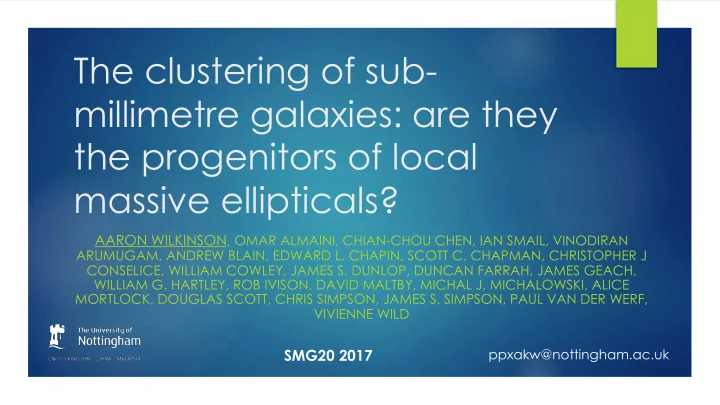

The clustering of sub- millimetre galaxies: are they the progenitors of local massive ellipticals? AARON WILKINSON , OMAR ALMAINI, CHIAN-CHOU CHEN, IAN SMAIL, VINODIRAN ARUMUGAM, ANDREW BLAIN, EDWARD L. CHAPIN, SCOTT C. CHAPMAN, CHRISTOPHER J CONSELICE, WILLIAM COWLEY, JAMES S. DUNLOP, DUNCAN FARRAH, JAMES GEACH, WILLIAM G. HARTLEY, ROB IVISON, DAVID MALTBY, MICHAL J. MICHALOWSKI, ALICE MORTLOCK, DOUGLAS SCOTT, CHRIS SIMPSON, JAMES S. SIMPSON, PAUL VAN DER WERF, VIVIENNE WILD SMG20 2017 ppxakw@nottingham.ac.uk
Motivation Processes responsible for the assembly of local massive elliptical galaxies u are not well understood. One way of studying the formation of these galaxies is to analyse the u clustering evolution of the progenitor candidate, sub-millimetre galaxies (SMGs), which can be done for the first time. From the clustering analysis, we can determine the mass of the dark u matter halo. Identify the true descendants of SMGs. u
UKIDSS Ultra Deep Survey (PI: O. Almaini) Sample drawn from the K-band of the u UDS survey Covers area of 0.88 square degrees u DR8: K=24.6, H=24.2, J=24.9 (DR11: u K=25.3) Deepest infrared survey covering such a u large area Photometric redshifts derived from 11- u band photometry δ z/(1+z)~ 0.03 u Hartley et al. 2013
SCUBA-2 Cosmology Legacy Survey Submillimetre Common-User Bolometer Array at u the JCMT Observe 850um fluxes within ~15” beam, with u sensitivity down to several mJy. Identify counterparts to poor resolution sources u using radio maps and Optical Infrared Triple Colour criteria (OIRTC; trained on ALMA sample) C.-C. Chen et al. (2016), ApJ, 820, 82
Clustering Analysis
Angular 2-point correlation function Measures the excess number of galaxy u pairs as a function of angular separation θ, with respect to a random distribution.
Angular 2-point correlation function Measures the excess number of galaxy u pairs as a function of angular separation θ, with respect to a random distribution. DM power spectrum -> Fourier u transform + project -> DM correlation x b 2 function Multiplication factor is the galaxy bias u squared, b 2 Derive halo masses from the galaxy u bias (Mo & White 2002)
Passive & star-forming halo masses STRONG CLUSTERING WEAK CLUSTERING Wilkinson et al. 2017
SMG halo masses STRONG CLUSTERING WEAK CLUSTERING Wilkinson et al. 2017
Correcting for blending bias… By using smaller u redshift slices, blending bias is reduced… Wilkinson et al. 2017 Cowley et al. 2016, 2017b
Take SMG halo masses… STRONG CLUSTERING WEAK CLUSTERING Wilkinson et al. 2017
… and grow them (Fakhouri+2010) STRONG CLUSTERING WEAK CLUSTERING Wilkinson et al. 2017
SMGs – progenitors of massive ellipticals STRONG CLUSTERING 2<z<2.5 SMGs -> u local massive elliptical galaxies ; with matching number densities z>2.5 SMGs -> u BCGs WEAK CLUSTERING Wilkinson et al. 2017
Post-starburst galaxies u “k+a” galaxies: Recently quenched (<1Gyr) after intense period of star formation u Spectral features: Balmer breaks and strong H δ absorption lines. u Identified photometrically using PCA technique (see Wild+2014) u Spectral confirmation : it works!! (Wild+2014, Maltby+2016)
STRONG CLUSTERING WEAK CLUSTERING
SMGs go through a post-starburst phase? STRONG CLUSTERING PRELIMINARY… WEAK CLUSTERING Wilkinson et al. in prep
Conclusions u SMG clustering signal indistinguishable from normal star-forming counterparts => SMGs = high-mass dusty subset of main-sequence galaxies. u SMGs show a downsizing trend with halo mass, as the Universe ages. u Evolution sequence: SMG -> (Post-starburst) -> Present-day massive ellipticals u What more could be done to test the connection between SMGs and other galaxy populations? How do SMGs shut off their star-formation?
Comparison to previous studies
Identifying SMG counterparts Identify counterparts using radio maps u and Optical Infrared Triple Colour criteria (OIRTC; trained on ALMA sample) Radio: identifies the brightest SMGs u OIRTC: (z – K), ([3.6] – [4.5]) and (K – [3.6]) u A sample of ~600 SMG counterparts in u total Chen et al. (2016)
Identifying PSB galaxies – the PCA The PCA - each SED is composed of a u linear combination of 3 eigenvectors Amplitude of eigenvectors = Supercolours u Calculate galaxy properties and classify u galaxies Wild et al. 2014
Identifying PSB galaxies – the PCA The PCA - each SED is composed of a u linear combination of 3 eigenvectors Amplitude of eigenvectors = Supercolours u Calculate galaxy properties and classify u galaxies Wild et al. 2014
Galaxy classification FRACTION CONTENT OF MASS u Data from the UKIDSS Ultra DUST Deep Survey DR8 u Identified ~1000 PSB galaxies in the UKIDSS UDS at 0.5<z<2.0, the largest high-redshift sample to date u Spectra confirmation is ongoing – so far we have spectra for 30 PSB candidates STELLAR AGE
Recommend
More recommend